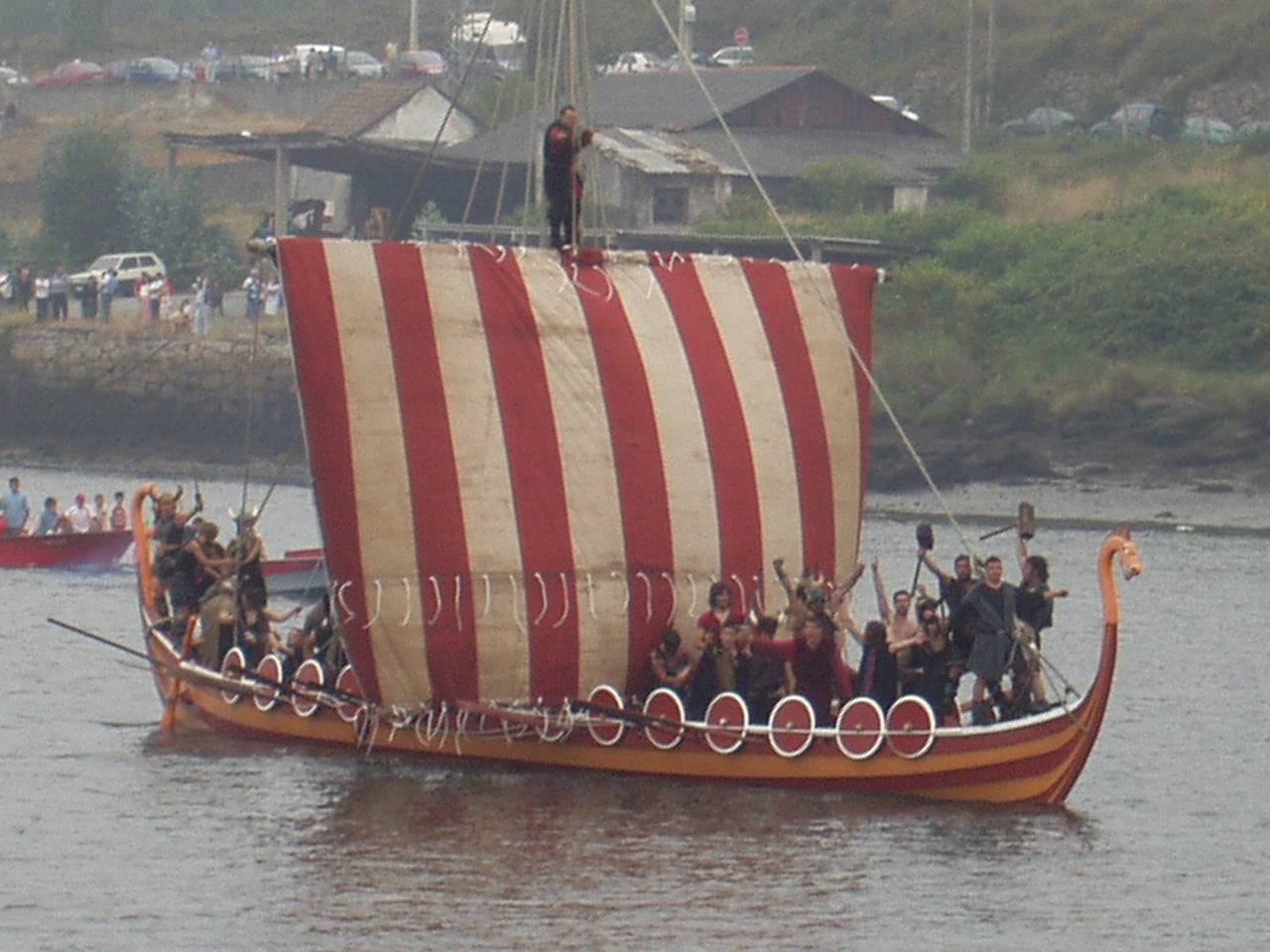Every year, on the first Sunday in August, the replica of an 11th-century Viking longboat sails up the river Ulla to the town of Catoira in northern Spain.

One of the ships used during the 2021 festival
The boat, manned by townsfolk disguised as Viking warriors (yet they use horned helmets, for Odin’s sake), stages a ferocious onslaught on the town, which is successfully fended off by the other residents in a tussle that ends up with both sides soaked not in blood, but wine.

Picture taken during the festival
After the battle, both victors and Vikings share a traditional lunch of mussels and octopus and perform a traditional Galician dance called the verbena. Last year (2021) there were actually six Viking longboats in the festival, a reflection of its growing popularity in the region.
The festival commemorates Galicia’s resistance to the Viking raids that took place there a more than 1,000 years ago, when the invaders tried to plunder the treasures of the cathedral of Santiago de Compostela.
Spain invaded and conquered more than any other European country except perhaps Russia. And, while Roman, Visigothic and Muslim heritages all live on today in varying degrees, the medieval legacy of the Vikings in Spain is more obscure.
During the Viking Age, most of the Iberian Peninsula was under muslim rule, with the remaining christian kingdoms fighting series of conflicts collectively known as “Reconquista”, taking place between the Umayyad conquest of Hispania in 711 and the fall of the Nasrid kingdom of Granada in 1492.
Most of what we know about the Viking raids come from accounts written by Arab historians, who referred to the Norsemen as majūs, meaning “heathen or worshipper of many gods”.
Despite the lack of information on the subject, the Viking raids in Spain were actually quite frequent, continuing util the end of the Viking era. The 11th-century Cordoban historian Ibn Hayyan provides early evidence of Viking attacks in the 960s and 970s, mainly in Galicia, al-Andalus and Lisbon. Galician charters some decades later describe the destruction of monasteries by the raiders.
Archaeologists have discovered the anchors of Viking longboats in Galicia washed ashore during a storm near what appears to be a Viking encampment.
The earliest Viking raid on Spain took place in the year 844. A Norse fleet with its blood red sails landed in Galicia after sacking Bordeaux, and proceeded to plunder the coastal villages until they were halted by the troops of King Ramiro I of Asturias near A Coruña on the northwestern coast of Galicia.

The best documented and most dramatic Viking assault occurred in September of the same year. The Norsemen sailed south from Galicia, ransacking en route the city of Lisbon, which was part of Muslim al-Andalus, and set their sights on Seville, then known by its Muslim name of Išbīliya.
They captured the city in early October after heavy fighting, but its citadel remained under Muslim control. According to the Muslim historian Nowairi, these Vikings terrorized the inhabitants of Seville and threatened them with imprisonment or death if they did not yield their city.

The emir of Cordoba, Abd al-Rahman II, acted swiftly by sending troops who were said to have destroyed thirty longboats, burning them with “Greek fire”, a concoction said to keep burning even when doused with water. Some further (muslim) accounts say this killed as many as 1,000 Vikings. Those captured were hanged from palm trees – though some are said to have converted to Islam to save their lives. Seville was left in ruins and its people traumatized, so Abd al-Rahman II ordered a shipyard to be built with a new fleet to guard the river Guadalquivir, which successfully deterred some of the future attacks.
In the following year (845) the Norsemen changed pace and decided to send an emissary to emir of Cordoba, who responded by appointing his famous court poet Al-Ghazal, the “Gazelle”, as ambassador at the court of King Horik of Denmark. Despite these diplomatic relations being opened, that did not prevent further Viking raids in Spain, which continued until the end of the Viking era.
Today, that ancient violence and terror has sparked an unlikely alliance between Galicia and Denmark: When the town council of Catoira took charge of organizing its Viking festival in 1991, an international link was created by twinning Catoira with the Danish town of Frederikssund in eastern Denmark, famous for its annual Viking games.

Viking Statue in Catoira, Spain
Sources:
Ann Christys. 2015. Vikings in the South. London: Bloomsbury. ISBN 9781474213783
Simek, Rudolf. 2007 (1993). Translated by Angela Hall. Dictionary of Northern Mythology. D.S. Brewer. ISBN 0-85991-513-1
Orchard, Andy. 1997. Dictionary of Norse Myth and Legend. Cassell. ISBN 0-304-34520-2
Drayson, Elizabeth. 2021. The conversation. Spain’s little-known Viking history is being uncovered.












